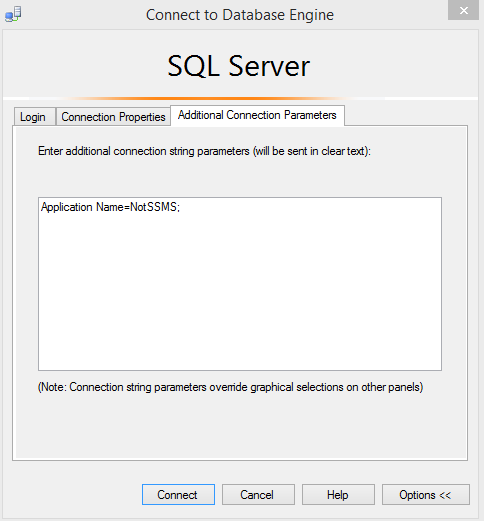:ON ERROR exit
:setvar PrimaryServer "ServerA"
:setvar PrimaryDatabase "MyDB"
:setvar PrimaryBackupDirectory "E:BackupDBTrxLogs"
:setvar PrimaryBackupShare "ServerAtrxlogs$"
:setvar SecondaryServer "ServerB"
:setvar SecondaryDatabase "MyDB"
:setvar SecondaryBackupDirectory "ServerBTrxlogs$TrxForRestore"
SET NOCOUNT ON
/* Begin: Script to be run at Primary */
:CONNECT $(PrimaryServer)
BEGIN
USE msdb;
/* Check to see if the backup folder exists */
RAISERROR('Checking to see if $(PrimaryBackupDirectory) exists...',0,1) WITH NOWAIT
DECLARE @CheckDir NVARCHAR(2000)
DECLARE @ErrorMsg NVARCHAR(200)
DECLARE @DirInfo TABLE
(
FileExists BIT ,
FileIsADirectory BIT ,
ParentDirectoryExists BIT
)
SET @CheckDir = '$(PrimaryBackupDirectory)'
INSERT INTO @DirInfo
( FileExists ,
FileIsADirectory ,
ParentDirectoryExists
)
EXECUTE [master].dbo.xp_fileexist @CheckDir
IF NOT EXISTS ( SELECT *
FROM @DirInfo
WHERE FileExists = 0
AND FileIsADirectory = 1
AND ParentDirectoryExists = 1 )
BEGIN
SET @ErrorMsg = 'The primary backup directory $(PrimaryBackupDirectory) does not exist...quitting'
RAISERROR(@ErrorMsg,16,1) WITH NOWAIT
RETURN
END
RAISERROR('$(PrimaryBackupDirectory) exists, continuing...',0,1) WITH NOWAIT
DECLARE @LS_BackupJobId AS uniqueidentifier
DECLARE @LS_PrimaryId AS uniqueidentifier
DECLARE @SP_Add_RetCode As int
RAISERROR('Enabling log shipping for $(PrimaryDatabase) on $(PrimaryServer)...',0,1) WITH NOWAIT
EXEC @SP_Add_RetCode = master.dbo.sp_add_log_shipping_primary_database
@database = N'$(PrimaryDatabase)'
,@backup_directory = N'$(PrimaryBackupDirectory)'
,@backup_share = N'$(PrimaryBackupShare)'
,@backup_job_name = N'LSBackup_$(PrimaryDatabase)'
,@backup_retention_period = 4320
,@backup_compression = 1
,@backup_threshold = 60
,@threshold_alert_enabled = 1
,@history_retention_period = 5760
,@backup_job_id = @LS_BackupJobId OUTPUT
,@primary_id = @LS_PrimaryId OUTPUT
,@overwrite = 1
IF (@@ERROR = 0 AND @SP_Add_RetCode = 0)
BEGIN
DECLARE @LS_BackUpScheduleUID As uniqueidentifier
DECLARE @LS_BackUpScheduleID AS int
EXEC msdb.dbo.sp_add_schedule
@schedule_name =N'LSBackupSchedule_$(PrimaryServer)'
,@enabled = 1
,@freq_type = 4
,@freq_interval = 1
,@freq_subday_type = 4
,@freq_subday_interval = 15
,@freq_recurrence_factor = 0
,@active_start_date = 20120607
,@active_end_date = 99991231
,@active_start_time = 0
,@active_end_time = 235900
,@schedule_uid = @LS_BackUpScheduleUID OUTPUT
,@schedule_id = @LS_BackUpScheduleID OUTPUT
EXEC msdb.dbo.sp_attach_schedule
@job_id = @LS_BackupJobId
,@schedule_id = @LS_BackUpScheduleID
EXEC msdb.dbo.sp_update_job
@job_id = @LS_BackupJobId
,@enabled = 1
END
EXEC master.dbo.sp_add_log_shipping_alert_job
EXEC master.dbo.sp_add_log_shipping_primary_secondary
@primary_database = N'$(PrimaryDatabase)'
,@secondary_server = N'$(PrimaryServer)'
,@secondary_database = N'$(SecondaryDatabase)'
,@overwrite = 1
RAISERROR('Log shipping enabled for $(PrimaryDatabase) on $(PrimaryServer)...',0,1) WITH NOWAIT
END
GO
/* ENDS THE PRIMARY SCRIPT */
/* Script to be run on secondary */
:CONNECT $(SecondaryServer)
USE msdb;
DECLARE @LS_Secondary__CopyJobId AS uniqueidentifier
DECLARE @LS_Secondary__RestoreJobId AS uniqueidentifier
DECLARE @LS_Secondary__SecondaryId AS uniqueidentifier
DECLARE @LS_Add_RetCode As int
RAISERROR('Adding log shipping secondary to $(SecondaryServer) with database name $(SecondaryDatabase)...',0,1) WITH NOWAIT
EXEC @LS_Add_RetCode = master.dbo.sp_add_log_shipping_secondary_primary
@primary_server = N'$(PrimaryServer)'
,@primary_database = N'$(PrimaryDatabase)'
,@backup_source_directory = N'$(PrimaryBackupShare)'
,@backup_destination_directory = N'$(SecondaryBackupDirectory)'
,@copy_job_name = N'LSCopy_$(PrimaryServer)_$(PrimaryDatabase)'
,@restore_job_name = N'LSRestore_$(PrimaryServer)_$(PrimaryDatabase)'
,@file_retention_period = 4320
,@overwrite = 1
,@copy_job_id = @LS_Secondary__CopyJobId OUTPUT
,@restore_job_id = @LS_Secondary__RestoreJobId OUTPUT
,@secondary_id = @LS_Secondary__SecondaryId OUTPUT
IF (@@ERROR = 0 AND @LS_Add_RetCode = 0)
BEGIN
DECLARE @LS_SecondaryCopyJobScheduleUID As uniqueidentifier
DECLARE @LS_SecondaryCopyJobScheduleID AS int
RAISERROR('Creating log shipping secondary jobs...',0,1) WITH NOWAIT
EXEC msdb.dbo.sp_add_schedule
@schedule_name =N'DefaultCopyJobSchedule'
,@enabled = 1
,@freq_type = 4
,@freq_interval = 1
,@freq_subday_type = 4
,@freq_subday_interval = 15
,@freq_recurrence_factor = 0
,@active_start_date = 20120607
,@active_end_date = 99991231
,@active_start_time = 0
,@active_end_time = 235900
,@schedule_uid = @LS_SecondaryCopyJobScheduleUID OUTPUT
,@schedule_id = @LS_SecondaryCopyJobScheduleID OUTPUT
EXEC msdb.dbo.sp_attach_schedule
@job_id = @LS_Secondary__CopyJobId
,@schedule_id = @LS_SecondaryCopyJobScheduleID
DECLARE @LS_SecondaryRestoreJobScheduleUID As uniqueidentifier
DECLARE @LS_SecondaryRestoreJobScheduleID AS int
EXEC msdb.dbo.sp_add_schedule
@schedule_name =N'DefaultRestoreJobSchedule'
,@enabled = 1
,@freq_type = 4
,@freq_interval = 1
,@freq_subday_type = 4
,@freq_subday_interval = 15
,@freq_recurrence_factor = 0
,@active_start_date = 20120607
,@active_end_date = 99991231
,@active_start_time = 0
,@active_end_time = 235900
,@schedule_uid = @LS_SecondaryRestoreJobScheduleUID OUTPUT
,@schedule_id = @LS_SecondaryRestoreJobScheduleID OUTPUT
EXEC msdb.dbo.sp_attach_schedule
@job_id = @LS_Secondary__RestoreJobId
,@schedule_id = @LS_SecondaryRestoreJobScheduleID
END
DECLARE @LS_Add_RetCode2 As int
IF (@@ERROR = 0 AND @LS_Add_RetCode = 0)
BEGIN
EXEC @LS_Add_RetCode2 = master.dbo.sp_add_log_shipping_secondary_database
@secondary_database = N'$(SecondaryDatabase)'
,@primary_server = N'$(PrimaryServer)'
,@primary_database = N'$(PrimaryDatabase)'
,@restore_delay = 0
,@restore_mode = 0
,@disconnect_users = 0
,@restore_threshold = 45
,@threshold_alert_enabled = 1
,@history_retention_period = 5760
,@overwrite = 1
END
IF (@@error = 0 AND @LS_Add_RetCode = 0)
BEGIN
EXEC msdb.dbo.sp_update_job
@job_id = @LS_Secondary__CopyJobId
,@enabled = 1
EXEC msdb.dbo.sp_update_job
@job_id = @LS_Secondary__RestoreJobId
,@enabled = 1
END
RAISERROR('Setup of log shipping from database $(PrimaryDatabase) on server $(PrimaryServer) to database $(SecondaryDatabase) on $(SecondaryServer) complete!',0,1) WITH NOWAIT





